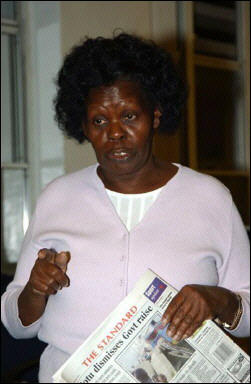A. SUMMARY OF THE CASE
1. As early as December 2006, WILLIAM SAMOEI RUTO (“RUTO”) and HENRY KIPRONO KOSGEY (“KOSGEY”), prominent leaders of the Orange Democratic Movement (“ODM”) political party, began preparing a criminal plan to attack those identified as supporters of the Party of National Unity (“PNU”).1 JOSHUA ARAP SANG (“SANG”), a prominent ODM supporter, was a crucial part of the plan, using his radio program to collect supporters and provide signals to members of the plan on when and where to attack. To reach their goal, RUTO, KOSGEY and SANG coordinated a series of actors and institutions to establish a network, using it to implement an organizational policy to commit crimes. Their two goals were: (1) to gain power in the Rift Valley Province, Kenya (“Rift Valley”), and ultimately in the Republic of Kenya, and (2) to punish and expel from the Rift Valley those perceived to support the PNU (collectively referred to as “PNU supporters”).
2. Kenyans voted in the presidential election on 27 December 2007. On 30 December 2007, the Electoral Commission of Kenya declared that Mwai Kibaki, presidential candidate for the PNU, had won the election. The announcement triggered one of the most violent periods in Kenya’s history. The Prosecution will present some of the incidents, identifying those who are most responsible.
3. Thousands of members of the network (“perpetrators”) cultivated by RUTO, KOSGEY and SANG began to execute their plan by attacking PNU supporters immediately after the announcement of the presidential election results on 30 December 2007. On 30‐31 December 2007, they began attacks in target locations including Turbo town, the greater Eldoret area (Huruma, Kimumu, Langas, and Yamumbi), Kapsabet town, and Nandi Hills town. They approached each location from all directions, burning down PNU supporters’ homes and businesses, killing civilians, and systematically driving them from their homes. On 1 January 2008, the church located on the Kiambaa farm cooperative was attacked and burned with more than one hundred people inside. At least 17 people died. The brunt of the attacks continued into the first week of January 2008.
4. All identified attacks occurred in a uniform fashion. Perpetrators gathered at designated meeting points outside of locations selected for attack. There, they met coordinators, who organized the perpetrators into groups with assigned tasks. Perpetrators then attacked target locations. Some perpetrators approached on foot, while others were driven in trucks, as had been previously arranged. SANG helped coordinate the attacks using coded language disseminated through radio broadcasts.
5. In response to RUTO, KOSGEY and SANG’s planned attacks on PNU supporters, as well as to deal with protests organized by the ODM, prominent PNU members and/or Government of Kenya officials FRANCIS KIRIMI MUTHAURA (“MUTHAURA”), UHURU MUIGAI KENYATTA (“KENYATTA”), and MOHAMMED HUSSEIN ALI (“ALI”) developed and executed a plan to attack perceived ODM supporters in order to keep the PNU in power.
6. First, under the authority of the National Security Advisory Committee, of which MUTHAURA and ALI were Chairman and a member, respectively, the Kenya Police, in joint operations with the Administration Police (“Kenyan Police Forces”), were deployed into ODM strongholds where they used excessive force against civilian protesters in Kisumu (Kisumu District, Nyanza Province) and in Kibera (Kibera Division, Nairobi Province). As a consequence, between the end of December 2007 and the middle of January 2008, the Kenyan Police Forces indiscriminately shot at and killed more than a hundred ODM supporters in Kisumu and Kibera.
7. Second, MUTHAURA, KENYATTA and ALI also developed a different tactic to retaliate against the attacks on PNU supporters. On or about 3 January 2008, KENYATTA, as the focal point between the PNU and the Mungiki criminal organization, facilitated a meeting with MUTHAURA, a senior Government of Kenya official, and Mungiki leaders to organize retaliatory attacks against civilian supporters of the ODM. Thereafter, MUTHAURA, in his capacity as Chairman of the National Security Advisory Committee, telephoned ALI, his subordinate as head of the Kenya Police, and instructed ALI not to interfere with the movement of pro‐PNU youth, including the Mungiki. KENYATTA additionally instructed the Mungiki leaders to attend a second meeting on the same day to finalize logistical and financial arrangements for the retaliatory attacks.
8. As a consequence, the Mungiki and pro‐PNU youth attacked ODM civilian supporters in Nakuru (Nakuru District, Rift Valley Province) and Naivasha (Naivasha District, Rift Valley Province) during the last week of January 2008. During these attacks, the attackers identified ODM supporters by going from door to door and by setting up road blocks for intercepting vehicles, killing over 150 ODM supporters.
9. The violence resulted in more than 1,100 people dead, 3,500 injured, approximately 600,000 victims of forcible displacement, at least hundreds of victims of rape and sexual violence and more than 100,000 properties destroyed in six out of eight of Kenya’s provinces. Many women and girls perceived as supporting the ODM were raped.
To get the full PDF document, send an empty email to siasaduni@gmail.com with the subject ICC Case 1 PDF.




Comments